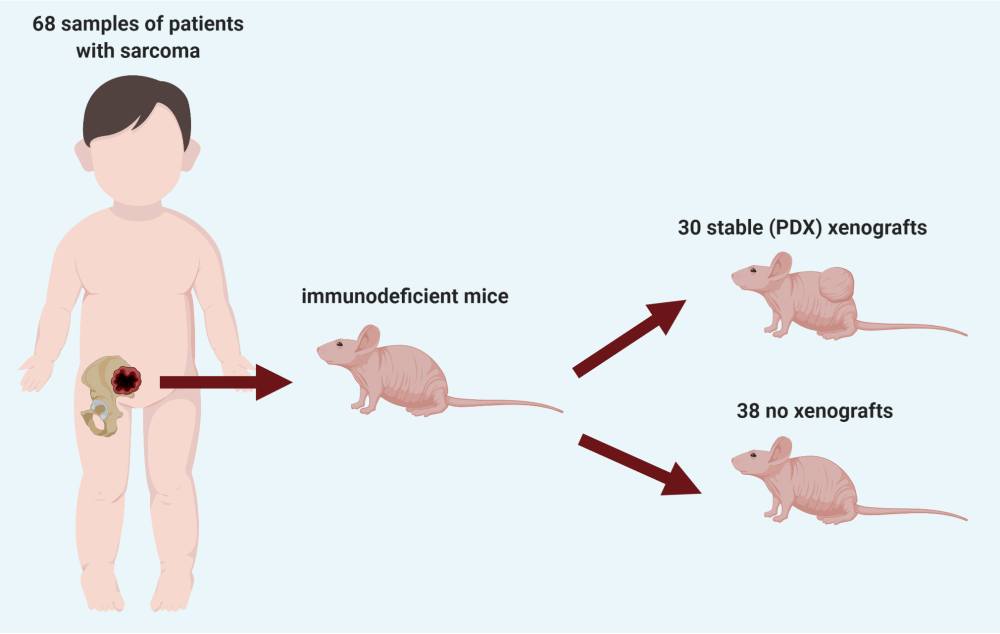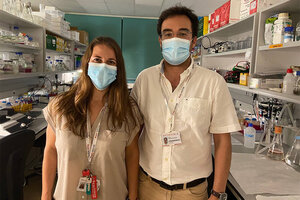Predicted prognosis of one type of childhood cancer by tumour engraftment in mice
Researchers of the Paediatric Cancer Program of the Institut de Recerca Sant Joan de Déu (IRSJD) and the SJD Barcelona Children's Hospital have made public their ten-year experience with the development of animal models of paediatric sarcomas, including Ewing sarcoma, rhabdomyosarcoma and osteosarcoma.
Over the course of this time, the research team has used immunodeficient mice to graft samples of patients' diseases with a view to developing immortalized animal models of tumours.
The project has been led by Dr Ángel Montero Carcaboso, head of the Paediatric Cancer Treatment group of IRSJD. The results of this study, whose first author is Helena Castillo Écija (IRSJD), are reported in a cover article of the scientific publication The Journal of Pathology. Clinical Research.
Paediatric sarcomas are an uncommon heterogeneous group of malignant neoplasias of the skeleton and the soft tissues, accounting for about 12% of all childhood solid tumours. The most frequent are Ewing sarcoma, osteosarcoma and rhabdomyosarcoma. With today's treatments, approximately 70% of patients survive the disease.
Animal tumour models, also called patient-derived xenografts (PDX), are now a promising tool for the precise personalized study of rare tumours. This tool even allows identification of possible treatments to be applied (depending on the genetics of the tumour), and characterization of the efficacy of different therapeutic strategies.
The researchers collected and inoculated in mice 68 tumour samples obtained from 51 children. Thirty samples successfully produced immortalized PDX. The results of the study show that the successful engraftment of tumours in the mice was associated with a poorer prognosis of the patients, that is to say, some of the patients whose tumours grew in the mice relapsed sooner or were more resistant to treatment.
"We wanted to assess whether these PDX could be useful for predicting the prognosis of paediatric sarcomas. Approximately 70% of the patients with these very serious diseases reach adult age, but that still leaves us with 30% for whom the treatments fail. Identifying factors that allow anticipation of the prognosis or selection of the most suitable treatment for each patient is one of the goals of our research", states Dr Ángel Montero Carcaboso.
The results of the study show that the success of PDX engraftment at the time of the initial diagnosis of the disease is a factor that could help to identify patients with a greater risk of future relapse of the disease.
Summing up, Helena Castillo Écija says: "Our ultimate goal is to provide much more personalized treatment to each patient, to identify beforehand the risk of relapse, and to design more specific and effective therapies for each one of these girls and boys".
The team led by Dr Montero Carcaboso recently achieved something never before reported in paediatric cancer, by succeeding in engrafting paired PDX models from one same patient in laboratory mice. Specifically, the researchers reproduced Ewing sarcomas from samples obtained in the early stage of the disease (at the time of diagnosis) and also in the advanced stage (when the disease reappeared). These experiments provide highly useful tools for studying the clinical evolution of this disease in the light of the treatments received by patients.

Reference
Castillo-Ecija H, Pascual-Pasto G, Perez-Jaume S, Resa-Pares C, Vila-Ubach M, Monterrubio C, Jimenez-Cabaco A, Baulenas-Farres M, Muñoz-Aznar O, Salvador N, Cuadrado-Vilanova M, Olaciregui NG, Balaguer-Lluna L, Burgueño V, Vicario FJ, Manzanares A, Castañeda A, Santa-Maria V, Cruz O, Celis V, Morales La Madrid A, Garraus M, Gorostegui M, Vancells M, Carrasco R, Krauel L, Torner F, Suñol M, Lavarino C, Mora J, Carcaboso AM. Prognostic value of patient-derived xenograft engraftment in pediatric sarcomas. J Pathol Clin Res. 2021 Jul;7(4):338-349. doi: 10.1002/cjp2.210. Epub 2021 Apr 9. PMID: 33837665.

The success of PDX engraftment at the time of the initial diagnosis of the disease is a factor that could help to identify patients with a greater risk of future relapse of the disease.
